Automatic Recognition of Medicinal Plants using Machine Learning Techniques
S. Vinothini1, J. Agnes21Student, M.E, Dept. of Computer Science and Engineering, T.J.S Engineering College, Tamil Nadu, India
2Assistant Professor, Dept. of Computer Science and Engineering, T.J.S Engineering College, Tamil Nadu, India

Abstract - A fully automated method for the recognition of medicinal plants using computer vision and machine learning techniques has been presented. Leaves from 24 different medicinal plant species were collected and photographed using a smart phone in a laboratory setting. A large number of features were extracted from each leaf such as its length, width, perimeter, and area, number of vertices, color, perimeter and area of hull. Several derived features were then computed from these attributes. The best results were obtained from a random forest classifier using a 10-fold cross-validation technique. With an accuracy of 90.1%, the random forest classifier performed better than other machine learning approaches such as the k-nearest neighbor, naïve Bayes, support vector machines and neural networks.
Key Words: Medicinal Plants, attributes, features, classifiercross-validation,leaves
1. INTRODUCTION
Identifying unknown plants relies much on the inherent knowledge of an expert botanist. The most successful methodtoidentifyplantscorrectlyandeasilyisamanualbased method based on morphological characteristics. Thus many of the processes involved in classifying these plant species are dependent on knowledge accumulation and skills of human beings. However, this process of manual recognition is often laborious and timeconsuming. Hence many researchers have conducted studies to support the automatic classification of plants basedontheirphysicalcharacteristics.Systemsdeveloped so far use a varying number of steps to automate the process of automatic classification, though the processes arequitesimilar.Essentially,thesestepsinvolvepreparing the leaves collected, undertaking some pre-processing to identify their specific attributes, classification of the leaves, populating the database, training for recognition and finally evaluating the results. Although leaves are most commonly used for plant identification, the stem, flowers, petals, seeds and even the whole plant can be used in an automated process. An automated plant identificationsystemcanbeusedbynon-botanicalexperts toquicklyidentifyplantspeciesquiteeffortlessly.
2. EXISTING SYSTEM
Thisresearchproposedanewmobileapplicationbasedon Android operating system for identifying Indonesian medicinal plant images based on texture and color featuresofdigitalleafimages.Intheexperimentsweused 51 species of Indonesian medicinal plants and each species consists of 48 images, so the total images used in this research are 2,448 images. This research investigates the effectiveness of the fusion between the Fuzzy Local Binary Pattern (FLBP) and the Fuzzy Color Histogram (FCH) in order to identify medicinal plants. The FLBP methodisused for extractingleafimage texture. TheFCH method is used for extracting leaf image color. The fusion of FLBP and FCH is done by using the Product Decision Rules (PDR) method. This research used Probabilistic NeuralNetwork(PNN)classifiersforclassifyingmedicinal plant species. The experimental results show that the fusion between FLBP and FCH can improve the average accuracy of medicinal plants identification. The accuracy of identification using fusion of FLBP and FCH is 74.51%. This application is very important to help people identify andfindinformationaboutIndonesianmedicinalplants.
3. PROPOSED WORK
The proposed technique was tested on a dataset of 55 medicinalplantsfromVietnamandaveryhighaccuracyof 98.3% was obtained with a support vector machines (SVM) classifier. The size of each image was 256*256 pixels. Proposed an approach based on fractal dimension features based on leaf shape and vein patterns for the recognition and classification of plant leaves. Using a knearest neighbor classifier with 20 features, they were able to achieve a high recognition rate of 87.1%. Using a volumetric fractal dimension approach to generate a texture signature for a leaf and the GLCM (Gray level co occurrencematrix)algorithm.
4. METHODOLOGY
Fig -1:ProposedMethodology
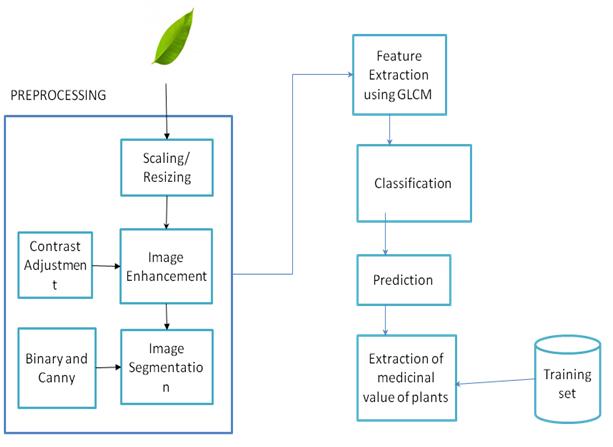

4.1 Preprocessing
Preprocessor does Preprocessing of the input image. There are 130 leaf images in our trained set. Preprocessing is a common name for operations with images atthelowestlevelofabstractionbothinputandoutputare intensity images The aim of Pre-processing is to scale the image size and improve the contrast of image that suppressesunwanteddistortionsorenhancessomeimage featuresimportantforfurtherprocessing.Thenextstepis to perform a thresholding operation which will convert theimageintoa binaryimagewithonlytwovalues:black and white pixels. This is achieved using the Binary and canny method. This operation is important in order to clear the image from many small noisy pixels, which are the artifacts of the thresholding operation. Preprocessor initially does Scaling or Resizing and gives Query Leaf image. Later the Image enhancer adjusts the Contrast of the resized image. The Image Segmenter segments the image using Binary and Canny. Now the preprocessor givesanoiselesssegmentedimageasinputtotheFeature Extractor.
4.2 Feature Extraction
The feature selection method is applied to take out unnecessary or irrelevant redundant properties from the set of extracted features that do not possess a substantial contributiontotheaccuracyoftheclassificationmodel or may even reduce the model accuracy. GLCM method is usedtopicksuptherelationbetweentwopixelsatatime, called the reference and the neighbour pixel. GLCM expounds the distance and angular spatial relationship over an image sub-region of specific size. GLCM is prepared from gray scale values. It is taken into account how often a pixel with gray level(gray scale intensity or gray tone) values come either horizontally, vertically and diagonally to leveled the pixels with the value j. GLCM
directions are: Horizontal(0) Vertical(90) Diagonal a)bottomlefttotopright(-45)b)toplefttobottomright(135). Feature Extractor uses Gray-Level Co-Occurrence Matrix(GLCM) method to extract features like grayco properties such as contrast, correlation, energy, homogeneity, mean, standard deviation, variance etc and region properties like area, centroid, bounding box, convexhull,eccentricityetc.Weextractnearly25features which produces more accuracy while identifying leaf. We train 130 leaf images in the dataset and store the identified feature values. The features such as area, perimeter,convexhullmean,standarddeviation,variance, horizontaldistance,verticaldistance,boundingboxetcare extractedusingglcm.Intotal,25featuresareextractedto achievehigherlevelofaccuracy.
4.3 Classification of Medicinal Leaves
Support vector machine isolates the input data linearly once it is directed to high dimensional space non-linearly and subsequently support vector machine is classified as non-linear classifier. This phenomenon of SVM enhances theclassificationperformance.BasicallySVMisamachine learning tool which has turned out as one of the capable problem solving method, problem related to binary classification and learning from data. SVM’s main concept between the two transformed space classes is, using kernel function transforming given data into higher dimensional space and developing OSH (Optimal SeparatingHyperplane).
This OSH is built by maximizing the edge between classes.Alineisconstructedinthechangedspaceandthe information vectors which are closest to this constructed line are known as support vectors. Function used for classifyingthedataintotwouniqueclassesisinspectedby the SVM.Inputvectorsare linearly isolated whichare put into high dimensional feature space by using non-linear transformation which is dependent on a regularization parameter.Innerproduct(x,y)issupplantedtoconstructa non-linearproductbykernelfunctionK(x,y)whichcanbe expressed as below: Where f indicates the member of x. Fromgivenkernel set,the basisK(xi,x)wherei=1,2,....N is selected using the first layer of the SVM and linear function in the space is created by second layer. SVM is independent of dimensionality of the input space. It has simple geometric construction and it generates spare solution. Classification is performed by support vectors n large number which is obtained by training set. We then compare the trained features with the features extracted byusalongwiththelabelsoftheleafusingSVMClassifier. Weusemultisvmwiththesethreeparameterstocompare and give the result based on the label. We predict the accurate matching and display the leaf with its name, medicinalvaluesandtheplaceitgrowsbycomparingwith thetrainedleafdataset.
4.4 Dataset
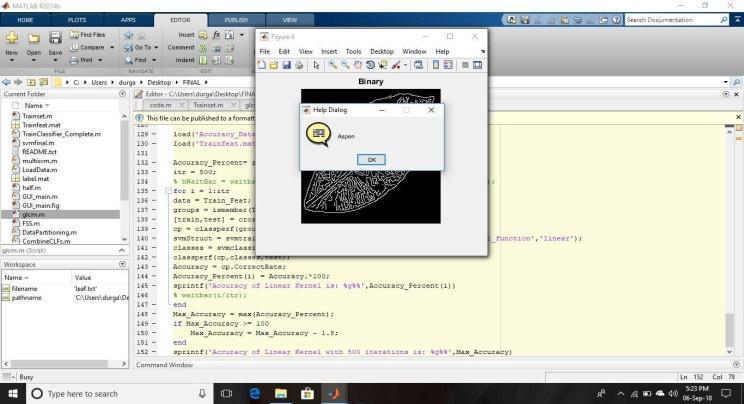

The dataset used in our experiment is collected by our self. We surfed the name, medicinal value of the plant by self. We have taken 130 images as training set and each plantclasscontainsthe10leafimagesindifferentdegrees of rotation and different leaf images. After classification, wecomparedthelabelvalue,trainedfeatures,thefeatures we extracted and the system displays the results of the name of the plant, its medicinal values and the place it grows.

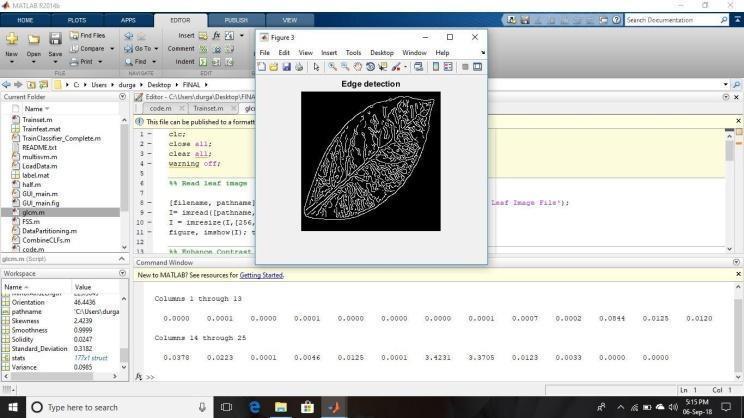
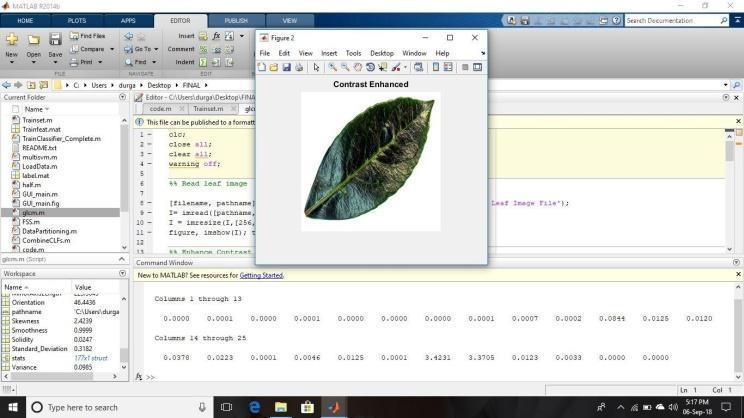
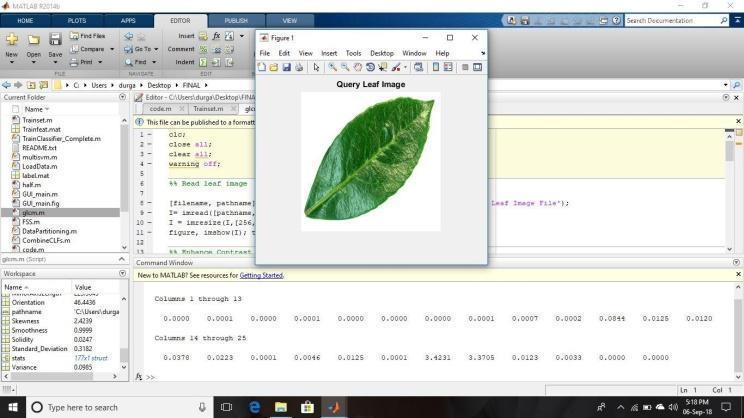


4.5 Leaves Recognition
Thevariousoutputsareshownbelow,
5. CONCLUSION
A new dataset on medicinal plants of Mauritius has been made publicly available on the machine learning repository portal. In this paper, computer vision techniqueshavebeenusedtoextractseveral shape-based features from the leaves of medicinal plants. Machine learning algorithms were then used to classify the leaves from 13 different plant species into their appropriate categories. The accuracy of our proposed method is comparatively higher than Existing system. For future research,in anattempttoachieve evenhigheraccuracies, probabilistic neural networks and deep learning neural networkswouldbeinvestigated.
6. FUTURE ENHANCEMENTS
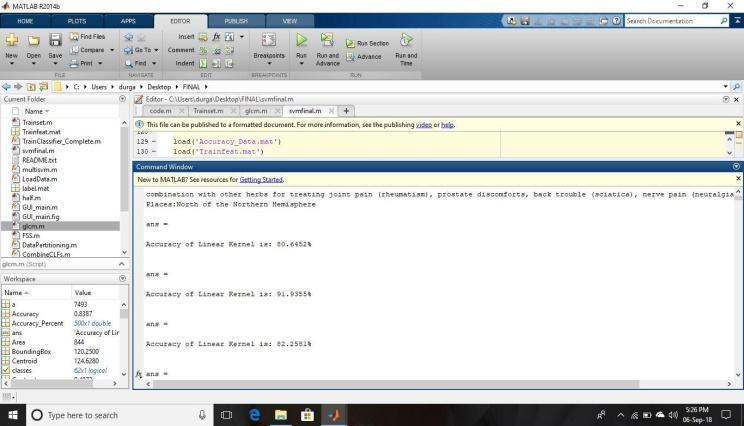
My future goal is to extend the current image processing desktopapplicationtoanandroidbasedsmart-phoneapp, one way to effectively achieve is to offload the processing of algorithms on to a high performance server over the network and this would typically work as a client server imageprocessingsystem.UsingtheAndroid basedsmartphone; the input image to be identified is captured and senttoaserver(eg.PHPServer)viaHTTP.Ascriptonthe server invokes the server-side application (eg. MATLAB) toprocesstheimagewhichinturnsendstheresultstothe smartphoneviahttp.Inanattempttoachieveevenhigher accuracies, probabilistic neural networks and deep learningneural networkswouldbeinvestigated.Different datasets may be incorporated to validate the obtained results and other effective classifiers may be applied. Additionally, deep learning technique can be used. This work is performed on the regional leaves. It can also be extendedtoalargernumberofleafclasseswithimproved efficiency. More extraction features can be used using increased number of leaf dataset in future work for leaf classification.
REFERENCES
[1] Gao, W. and Lin, W., 2019. Frontal Parietal Control Network Regulates the Anti-Correlated Default and DorsalAttentionNetworks.HumanBrainMapping.
[2] Wu,S.G.,Bao,F.S., Xu, E.Y., Wang, Y.X.,Chang, Y.F.and Xiang, Q.L., 2017. A Leaf Recognition Algorithm for Plant Classification using Probabilistic Neural Network.7thIEEEInternationalSymposiumonSignal Processing and Information Technology, Giza, Egypt, 11-16.
[3] ZhangX.,LiuY.,LinH.,LiuY.(2018)ResearchonSVM PlantLeafIdentificationMethodBasedonCSA.In:Che W. et al. (eds) Social Computing. ICYCSEE 2016. Communications in Computer and Information Science,Vol624,Springer,Singapore.
[4] Hossain, J. and Amin, M.A., 2019. Leaf Shape Identification Based Plant Biometrics. 13th International Conference on Computer and InformationTechnology,Dhaka,Bangladesh,458-463.
[5] Du, J.X., Wang, X.F. and Zhang, G.J., 2017. Leaf shape based plant species recognition. Applied Mathematics andComputation,185,883-893.
[6] Du, M., Zhang, S. and Wang, H., 2009. Supervised Isomap for Plant Leaf Image Classification. 5th International Conference on Emerging Intelligent ComputingTechnologyand Applications,Ulsan,South Korea,627-634.

[7] Herdiyeni, Y. and Wahyuni, N.K.S., 2020. Mobile Application for Indonesian Medicinal Plants Identification using Fuzzy Local Binary Pattern and Fuzzy Color Histogram. International Conference on AdvancedComputerScienceandInformationSystems (ICACSIS),WestJava,Indonesia,301-306.
[8] Prasvita,D.S.andHerdiyeni,Y.,2019.MedLeaf:Mobile Application for Medicinal Plant Identification Based on Leaf Image. International Journal of Advanced Science, Engineering and Information Technology, 3, 5–8.
